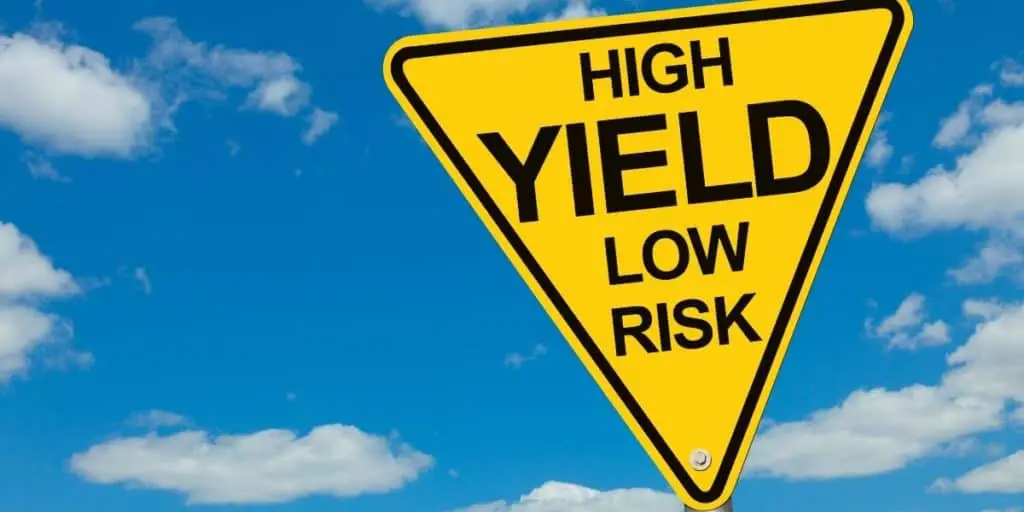Mutual funds are a safer investment method than buying and selling a few individual stocks through a stockbroker. With mutual funds, your risk is diversified, and a professional, experienced fund manager manages your investment. But are there safer investment avenues than mutual funds?
Mutual funds aren’t the safest investments, and even though protecting your principal while still earning a return is your top priority, there are safer places to park your money. You could invest in treasury notes or bonds, high yield savings accounts, or even money market funds.
Investments carry a degree of risk, and everybody needs to know their risk comfort level. Unfortunately, there’s no sure thing in the investment world. However, we have some suggestions that are safer than a mutual fund, so read on to see the possibilities.
IMPORTANT SIDENOTE: I surveyed 1500+ traders to understand how social trading impacted their trading outcomes. The results shocked my belief system! Read my latest article: ‘Exploring Social Trading: Community, Profit, and Collaboration’ for my in-depth findings through the data collected from this survey!
Table of Contents
Let’s Talk About Low-Risk Investment Returns
Low-risk investments return low earnings, and if keeping your money safe is more important than risking it to earn more, then you’ll be comfortable with that arrangement.

When you invest money, you’re making a loan with the expectation that you’ll retain your initial investment along with a rate of return. The higher the risk, the greater the possible return and the greater the risk of loss.
Mutual funds might not always be the best investment choice, as fund managers might choose to invest in riskier investments. However, if you choose other investments on your own, you might fare better in the long term.
Low-risk investments are usually more liquid, and the time may come when you need quick access to your investment funds.
Which Investors Need Low-Risk Investments?
Investors who are close to retirement need low-risk investments. They also need a safe emergency fund and invest safely when they are custodians of dedicated funds or are beneficiaries of a lump-sum payout.
The safest investments are the wisest option when you can’t afford to lose the money invested. Let’s take a look at some of the situations where you need low-risk investments.
- When you start in life, the first money account you need is your emergency fund to cover those first three months of expenses. You want quick and easy access to that money with little or no penalty for withdrawal.
- If you’re the custodian of funds designated for the future care of a minor child, disabled adult, or older adult, you want a safe place for that money. You still want the money to grow, but you can’t risk the loss of capital. Look for the safest options.
- You may have been steadily investing throughout your working life at varying degrees of risk. But as you get closer to retirement, only low risk is acceptable as you plan for your immediate future income needs.
- Money needs to be kept safe when living expenses are based on a lump sum payout such as life insurance, settlement, or inheritance. The safest investments will protect the principal and hopefully earn enough to keep up with inflation.
Low-Risk Investments Are Safer Short Term
If you only want to protect your principal, you might deposit your money in an insured savings account paying 2% interest. If you let it sit there for a few years, you’ll eventually lose the interest you’ve earned and a portion of the principal to inflation.
That’s not an investment strategy. Your money is simply eroding.
For long-term investments, mutual funds might be safer, as your money is diversified and earning an average of 10% interest. You can afford some fluctuation. However, make sure that your fund manager is working with you on your investing goals.
Low-risk investing is better suited to short-term goals, but even then, you should make sure the earnings are keeping up with inflation.
11 Investments Safer Than Mutual Funds
Described below are the 11 short term, low risk investments that are perhaps that safest investments you can find out there:
Government Bonds
According to Forbes, Government Bonds are the safest investment after a Savings Account. The government always pays their debts, which makes them a reliable investment. Bonds pay interest every six months, and you can choose maturity dates from 30 days to 30 years.
Treasury Notes
Treasury notes pay interest every six months with maturities from two to ten years and are issued in terms of 2, 3, 5, 7, and 10 years. The 10-year Treasury note is frequently used as a benchmark for other loan interest rates. You can sell Treasury notes through a broker before they mature, but you may lose money on the transaction.
Treasury Bills
Treasury Bills are sold at less than face value and mature in a year or less.
Collectively, these first three selections are referred to as Treasuries. Since they are a reliable investment, they are also reasonably liquid. Their reliability makes them easy to buy and sell if you need to cash out early.
High Yield Savings Accounts
These savings accounts are low risk because they are FDIC insured for up to $250,000. As a result, they would be no riskier than any bank account except that the risk of long-term returns doesn’t keep pace with inflation.
Money Market Funds
A money market fund is a mutual fund of short-term debt and cash. They’re almost as safe as cash, but the return is negligible. Money Market Funds look like a bank account complete with a debit card, and the funds are highly liquid.
It’s a good instrument for short-term savings for significant purchases or accumulating the funds necessary to invest in a higher-yielding product.
Certificate of Deposit
CDs have a fixed maturity date. They’re issued by banks and insured up to $250,000 by FDIC, so they’re risk-free. Shop around for the best rates.
Larger deposits may garner a higher interest rate, and so do longer terms.
If you want to take on a little more risk, non-insured facilities like credit unions offer a slightly higher interest rate.
High Yield Savings Accounts
High yield savings accounts are FDIC insured by the issuer just like any other bank account, but the similarities stop there.
Banks issuing high yield accounts pay interest rates up to 25 times greater than your local bank.
Most high yield savings accounts are offered by online banks, which may be their only service. There are no debit cards, and all transfers must be electronic, but it is a short-term holding place for cash.
Corporate Bonds
Corporate bonds are considered low risk if you invest only in high-quality corporate bonds. For example, a well-established corporation would issue those with an excellent credit rating. Therefore, the likelihood they’ll pay the debt is good.
Fixed Annuity
Annuities are low-risk long-term investments usually issued by insurance companies. You can pay into the annuity fund over time or with a lump sum. The interest rate is fixed, and so is the agreed start of distribution.
If you pull money out of the fund ahead of time, the penalty will be significant. The agreement is that you’ll receive a monthly income at the specified time, such as upon retirement. If it’s a 20-year annuity, you could lose principal and interest to inflation.
Series EE and I Bonds
The government issues these bonds at a cost less than face value. In addition, the minimum time to hold them without penalty is five years, so they’re a low-risk investment.
The benefit is if you need to redeem them early to pay for higher education, the penalty costs can be deducted from your gross income at tax time.
Real Estate
Real estate, especially your home, is one long-term investment that’s very low risk. In addition, it’s somewhat liquid because mortgage lenders make it easy to withdraw equity from your home if needed.
But real estate can be a short-term investment as well. If you paid a fair price when you bought the home, five years later, if you sell it, you can expect a profit in most housing markets.

Author’s Recommendations: Top Trading and Investment Resources To Consider
Before concluding this article, I wanted to share few trading and investment resources that I have vetted, with the help of 50+ consistently profitable traders, for you. I am confident that you will greatly benefit in your trading journey by considering one or more of these resources.
- Roadmap to Becoming a Consistently Profitable Trader: I surveyed 5000+ traders (and interviewed 50+ profitable traders) to create the best possible step by step trading guide for you. Read my article: ‘7 Proven Steps To Profitable Trading’ to learn about my findings from surveying 5000+ traders, and to learn how these learnings can be leveraged to your advantage.
- Best Broker For Trading Success: I reviewed 15+ brokers and discussed my findings with 50+ consistently profitable traders. Post all that assessment, the best all round broker that our collective minds picked was M1 Finance. If you are looking to open a brokerage account, choose M1 Finance. You just cannot go wrong with it! Click Here To Sign Up for M1 Finance Today!
- Best Trading Courses You Can Take For Free (or at extremely low cost): I reviewed 30+ trading courses to recommend you the best resource, and found Trading Strategies in Emerging Markets Specialization on Coursera to beat every other course on the market. Plus, if you complete this course within 7 days, it will cost you nothing and will be absolutely free! Click Here To Sign Up Today! (If you don’t find this course valuable, you can cancel anytime within the 7 days trial period and pay nothing.)
- Best Passive Investment Platform For Exponential (Potentially) Returns: By enabling passive investments into a Bitcoin ETF, Acorns gives you the best opportunity to make exponential returns on your passive investments. Plus, Acorns is currently offering a $15 bonus for simply singing up to their platform – so that is one opportunity you don’t want to miss! (assuming you are interested in this platform). Click Here To Get $15 Bonus By Signing Up For Acorns Today! (It will take you less than 5 mins to sign up, and it is totally worth it.)
Conclusion
The investment products listed in this article are safer because they’re like savings accounts. In addition, some of these investment products are insured. Any of them may be the best place for you to park your money to save and accumulate your emergency fund.
When the time comes to put your money to work building wealth for the future, a professionally managed mutual fund is your safest investment. Admittedly, it’s a little riskier, but long term, you’ll be able to weather the ups and downs of the markets and reach your financial goals.
BEFORE YOU GO: Don’t forget to check out my latest article – ‘Exploring Social Trading: Community, Profit, and Collaboration’. I surveyed 1500+ traders to identify the impact social trading can have on your trading performance, and shared all my findings in this article. No matter where you are in your trading journey today, I am confident that you will find this article helpful!
Affiliate Disclosure: We participate in several affiliate programs and may be compensated if you make a purchase using our referral link, at no additional cost to you. You can, however, trust the integrity of our recommendation. Affiliate programs exist even for products that we are not recommending. We only choose to recommend you the products that we actually believe in.
